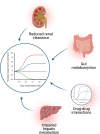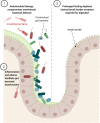Tertiary peritonitis: considerations for complex team-based care
- PMID: 34302503
- PMCID: PMC8308068
- DOI: 10.1007/s00068-021-01750-9
Tertiary peritonitis: considerations for complex team-based care
Abstract
Peritonitis, as a major consequence of hollow visceral perforation, anastomotic disruption, ischemic necrosis, or other injuries of the gastrointestinal tract, often drives acute care in the emergency department, operating room, and the ICU. Chronic critical illness (CCI) represents a devastating challenge in modern surgical critical care where successful interventions have fostered a growing cohort of patients with prolonged dependence on mechanical ventilation and other organ supportive therapies who would previously have succumbed much earlier in the acute phase of critical illness. An important subset of CCI patients are those who have survived an emergency abdominal operation, but who subsequently require prolonged open abdomen management complicated by persistent peritoneal space infection or colonization, fistula formation, and gastrointestinal (GI) tract dysfunction; these patients are described as having tertiary peritonitis (TP).The organ dysfunction cascade in TP terminates in death in between 30 and 64% of patients. This narrative review describes key-but not all-elements in a framework for the coordinate multiprofessional team-based management of a patient with tertiary peritonitis to mitigate this risk of death and promote recovery. Given the prolonged critical illness course of this unique patient population, early and recurrent Palliative Care Medicine consultation helps establish goals of care, support adjustment to changes in life circumstance, and enable patient and family centered care.
Keywords: Critical care; Infection; Morbidity; Mortality; Surgery; Tertiary peritonitis.
© 2021. Springer-Verlag GmbH Germany, part of Springer Nature.
Conflict of interest statement
The authors have no conflicts of interest to disclose.
Figures






References
-
- Vincent J-L, Rello J, Marshall J, Silva E, Anzueto A, Martin CD, et al. International study of the prevalence and outcomes of infection in intensive care units. JAMA. 2009;302:2323–2329. - PubMed
-
- Inui T, Haridas M, Claridge JA, Malangoni MA. Mortality for intra-abdominal infection is associated with intrinsic risk factors rather than the source of infection. Surgery. 2009;146:654–662. - PubMed
-
- Schein M, Marshall J. Source control for surgical infections. World J Surg. 2004;28:638–645. - PubMed
-
- Sawyer RG. Source control, a guide to the management of surgical infections. Berlin: Springer; 2003. pp. 341–347.
Publication types
MeSH terms
LinkOut - more resources
Full Text Sources

